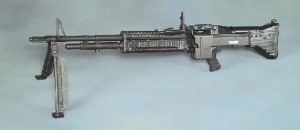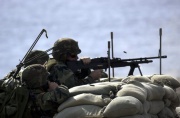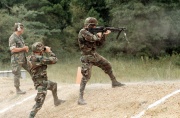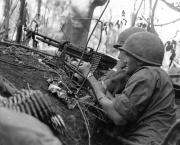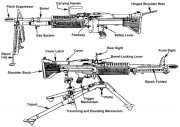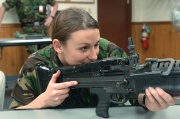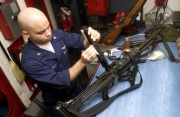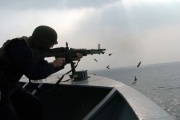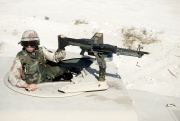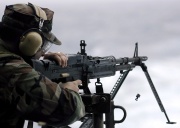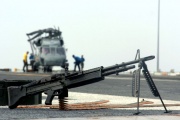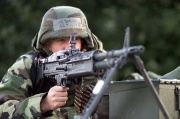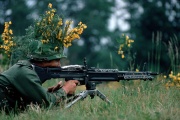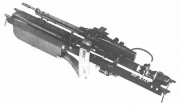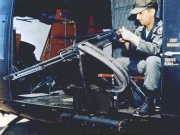M60 machine gun
| |||||||||||||||||||||||||||||||||||||||||||||||||||||||||
The M60 (formally the United States Machine Gun, Caliber 7.62 mm, M60) is a family of American general purpose machine guns firing 7.62x51mm NATO cartridges from a disintegrating belt of M13 links.
Introduced in 1957, until recently it remained in use in every branch of the U.S military and still serves in other armed forces. Its manufacture and continued upgrade for military and commercial purchase continues into the 21st century though it has been replaced or supplemented in most roles by other designs, notably the M240 (U.S. Forces' nomenclature for the FN MAG-58) in U.S service.
Contents[hide] |
[edit] The M60 machine gun family
- For information on specific types, see Variants below.
The nomenclature M60 describes either the first adopted version or, generically, the family of weapons derived from it.
Major variations include the M60E1 (an improved version that did not enter production), the M60E2 (a version designed to be used from fixed mounts as a co-axial for armored vehicles or in helicopter armament systems), the M60E3 (a lightweight version) and the M60E4 (another improved version, designated Mk 43 Mod 0 by the U.S. Navy).
The M60C was adopted for use on fixed mounts on aircraft. It was characterized by the use of an electric solenoid to operate the trigger and a hydraulic system to charge the weapon. The M60D differed from the base model by employing spade grips, a different sighting system, and lacking a forearm. It was typically employed as a door gun on helicopters or as a pintle mounted weapon as on the Type 88 K1 tank.
There are many smaller variants among each type, between makers of the firearm, and over time.
[edit] Overview
The M60 is an air-cooled and gas-operated machine gun firing from an open bolt. It chambers the 7.62x51mm NATO cartridge and feeds from a disintegrating belt of metallic M13 links. In most variants, it has an integrated folding bipod and can be mounted on the M122 Tripod and some fixed mounts.
In the U.S. military, the M60 has largely been replaced by versions of the M240 in the medium machine gun and fixed weapon roles, and by the M249 as a squad automatic weapon. It remains in use in every branch of the U.S. military (as well as other armed forces) and continues to be manufactured.
The M60 is considered effective up to 1,100 meters when firing at an area target and mounted on a tripod; up to 800 meters when firing at an area target using the integral bipod; up to 600 meters when firing at a point target; and up to 200 meters when firing at a moving point target. United States Marine Corps doctrine holds that the M60 and other weapons in its class are capable of suppressive fire on area targets out to 1,500 meters if the gunner is sufficiently skilled.
The M60 is generally used as crew-served weapon and operated by a team of two or three men. The team consists of the gunner, the assistant gunner (A-gunner in military slang), and the ammunition bearer. The gun's weight and the amount of ammunition it consumes when fired make it difficult for a single soldier to carry and operate. The gunner carries the weapon and, depending on his strength and stamina, anywhere from 200 to 1000 rounds of ammunition. The assistant carries a spare barrel and extra ammunition, and reloads and spots targets for the gunner. (The latter task, because it requires the soldier to keep his head up while under fire, makes the A-gunner one of the most dangerous and thus least sought after and least desirable assignments in the military.) The ammunition bearer carries additional ammunition and the tripod with associated traversing and elevation mechanism, if issued, and fetches more ammunition as needed during firing. The basic ammunition load carried by the crew is 600 to 900 rounds and theoretically allows approximately two minutes of continuous firing at the maximum rate of fire. All crews carry more than the basic load, sometimes three or more times the basic amount if they can get it. In many U.S. units that used the M60 as a squad automatic weapon in Vietnam, every soldier in the rifle squad would carry an additional 200 linked rounds of ammunition for the M60, a spare barrel, or both, in addition to his personal weapon and equipment.
Unlike the M240 variants replacing it, the M60 can be accurately fired at short ranges from the shoulder due to its design. This was an initial requirement for the design and a hold-over in concept from the Browning Automatic Rifle. It may also be fired from the M122, the integral bipod, and some other mounts. Originally an experimental M91 tripod was developed for the M60, but an updated M2 Tripod design was selected over it which became the M122. The M122 would be itself replaced in the 2000s by a new mount, in time for the M60 to also be used with it.
M60 ammunition comes in a cloth bandoleer containing a cardboard box of 100 pre-linked rounds. The M60 changed from M1 link to the different M13 link, a change from the older link system with which it was not compatible. The M240 continues to use the M13 link. The cloth bandoleer is reinforced to allow it to be hung from the current version of the feed tray. Historically, units in Vietnam used B3A cans from C-rations packs locked into the ammunition box attachment system to roll the ammunition belts over for a straighter and smoother feed to the loading port to enhance reliability of feed. The later models changed the ammunition box attachment point and made this adaptation not possible.
[edit] History
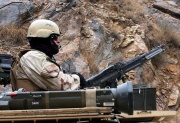
The M60 machine gun began development in the late 1940s as a program for a new, lighter 7.62 mm machine gun. The design included features that had been successful on earlier designs (most notably the German MG42), as well as improvements of its own. It was intended to replace the Browning Automatic Rifle and M1919A6 Browning machine gun in the squad automatic weapon role. It was also to replace the M1919 family in the medium machine gun role. One of the weapons tested against it during its procurement process was the FN MAG.
The U.S. Army officially adopted the M60 in 1957.
After the failure of the M73 Machine gun as a coaxial weapon and its replacement by the M240, variants of the FN MAG (usually those derived from the British versions) also replaced M60 variants on armored vehicles in US service.
In the 1980s, it was partially replaced by the M249 Squad Automatic Weapon within the Infantry squad. The M60 was retained in the vehicle mounted role and the general-purpose role due to its greater power and range compared to the 5.56 mm M249. In USMC service, concerns about the M60's reliability, the system's weight, and high round counts of many M60s in service prompted the adoption of the M60E3 to replace most original M60s in Infantry units.
Continued dissatisfaction by the Marines prompted them to begin replacing their M60s and M60E3s with M240s made surplus by the drawing down of US forces and the replacement or obsolescence of some Army and Marine armored vehicles. Starting with Ranger Battalions, the US Army began adopting and modifying M240 variants for replacing their remaining M60s in the early 1990s. By comparison, the M240 is several pounds heavier than the M60, and has a longer barrel and overall length, but is measurably more reliable in use and testing. However, the M60 uses a much simpler gas system that is, when care is taken during reassembly, easier to clean. This advantage is obviated by the fact that, in practice, the gas tube is wired shut with lockwire to prevent the gun from disassembling itself due to vibration in hard use.
In Australia, the M60 was replaced by the F89, an Australian built version of the FN Minimi, and is still in use (as of 2006). Its reputation varies widely, and often depends upon which version a person gained experience with, and when.
The M60 continued to be used by U.S. Navy SEALs and as a door gun on U.S. Army helicopters into the 21st century, and as the main 7.62 mm machine gun by some U.S. special operations forces into the late 1990s. As of 2005, it is used by the Coast Guard, Navy, and a number of reserve forces, though it is rapidly being phased out in favor of the M240 7.62 mm medium machine gun. The weapon can still be found in use in the U.S. Army and special operations forces in other roles. The use as an Army helicopter door gun will soon be tapering off, as an improved M240 version has finally been adopted for this role in the later half of the decade.
Use of the M60 is tapering off over a long period, as the weapons in service slowly wear out (and then new weapons are bought) or when a new weapon is obtained for a given job. Also, subgroups that continue to use them may obtain funding to keep models in service. One unit might have received new M240s, only to give their M60s to a reserve unit, sometimes replacing an even older weapon. It also remains in use in other countries in a variety of roles. The M240 itself has been slated for eventual replacement under a program for a new lightweight 7.62 mm machine gun under Joint Service Small Arms Program (JSSAP).
[edit] Design
The M60 is a gas-operated, air-cooled, belt-fed, automatic machine gun that fires from the open-bolt position and is chambered for the 7.62 mm NATO cartridge. Ammunition is usually fed into the weapon from a 100-round bandolier containing a disintegrating, metallic split-link belt. As with all such weapons, it can be fired from the shoulder, hip, or underarm position. However, to achieve the maximum effective range, it is recommended that a bipod-steadied position or a tripod-mounted position be used and fired in bursts of 3–5 rounds. The weapon is heavy and difficult to aim when firing without support, though the weight helps reduce the felt recoil. The straight-line layout allowed the operating rod and buffer to run directly back into the buttstock and reduce the overall length of the weapon. The large grip also allowed the weapon to be conveniently carried at the hip. The gun can be stripped using a live round of ammunition as a tool.
The design drew on many common concepts in firearms manufacture of the period, such as stamped sheet metal construction, belt feed (a modified mechanism for belt feed from the MG42 with a single pawl), quick barrel replacement, a pistol grip and stock, and a semi-bull pup design similar to the FG42 (much of the action occupies the weapon's stock). The M60's operating system of an operating rod turning a rotating bolt was inspired by the FG42, which was based on the much earlier Lewis Gun. The M60's gas operation is unique, and drew on technical advances of the period, particularly the White "gas expansion and cutoff" principle also exploited by the M14 rifle. The M60's gas system was simpler than other gas systems and easier to clean.
The M60 is often used with its own integrated bipod or with the M122 tripod.
[edit] Design & performance
When tested in the field, the M60 was fairly effective, but in the jungles of Southeast Asia in which it was soon used, the initial versions displayed several potential problems when used on the ground. A common complaint was the weapon's weight, a common problem with battle rifle-caliber machine guns. The M60 was among the lightest 7.62 mm machine guns of the era and lighter than the M240 that is replacing it.
For units in Vietnam, the single most common complaint was that the M60 was comparatively unreliable and prone to jamming and other malfunctions, especially when it was dirty. Fine sand and dust in the mechanism could bring the M60 to a halt. This was a major factor in the Israeli Defense Force declining to adopt the M60. The weapon was more difficult to clean and maintain than the M1918A2 Browning Automatic Rifle (BAR) it replaced in the squad. In normal conditions it would often fire thousands of rounds without a serious jam while field conditions tended to reduce reliability without proper maintenance.
The safety was awkward to operate and worked the "wrong way" for soldiers who were trained with the M16 rifle and M1911A1 pistol — that is, it required an upward movement of the thumb on the safety catch to make the gun ready to fire, rather than a downward movement as with the other weapons. Additionally, it is possible to install some of the fire control mechanism incorrectly, causing a "runaway gun" - meaning that it would keep firing until empty even if the operator took his finger off the trigger. The gas system of the original model could be assembled incorrectly causing failure to function and could unscrew and come apart if not safely wired in place.
The M60 sometimes (depending on the version) tore rims off of fired cartridge cases during the extraction cycle, resulting in failure to remove the empty case, causing a jam that could take time to clear. The barrel latch mechanism (a swinging lever) could catch on the gunner's equipment and accidentally unlatch, causing the barrel to fall out of the gun. The lever was replaced with a pushbutton mechanism that was less likely to be accidentally released, but many of the swinging-lever latches are still on guns in inventory, forty years after this problem was discovered.
The grip/trigger housing assembly is held in place with a rather fragile leaf spring clip instead of the captive pins used in other designs. The spring clip has been known to be prone to breakage since the first trials at Aberdeen Proving Ground. Duct tape and cable ties have been seen on M60s in the field, placed there by their crews in case the spring clip breaks. The sear in the trigger mechanism gained a reputation for wearing down and a malfunction could cause the gun to "run away".
Several critical parts of early production M60s, such as the receiver cover and feed tray, were made from very thin sheet metal stampings and prone to bending or breaking; sturdier parts were eventually available in the early 1970s. Early M60s also had driving spring guides and operating rods that were too thin and gas pistons that were too narrow behind the piston head (part of an attempt to save weight), leading to problems with breakage. Metallurgical problems also played a part, (blamed by some on low-bid contractors), but after 1970 a slightly heavier part was designed and slowly put into the supply chain. High round count weapons were also susceptible to stretching of the receiver and other parts.
Another criticism with some versions of the M60 is that the barrel was heavy. The bipod was a permanent fixture to the barrel as well as the gas chamber of the gas system; the latter was a result of using a piston design with a fixed regulator design. The advantage of the fixed regulator was no adjustment was required, though it risked the ability to compensate for fouling of the gas system, leading to insufficient power to operate the action, including lifting the ammunition belt. The non-adjustable front sight is fixed to the barrel and adjustments for "zeroing" the sights could only be made at the rear sight requiring readjustment when the barrel is changed—not ideal for combat situations.
There was no handle to hold the barrel by for changes. A large asbestos glove was part of the standard issue to allow the crew to handle hot barrels during barrel change. Loss of the glove was always a problem.
U.S. Marines especially disliked the M60, and many Marine units held onto their BARs until 1967-68 officially, and longer unofficially. The M60E3 variant designed in the mid-1980s for the U.S. Marine Corps, reduced the design's weight to 18.9 lb (8.61 kg) unloaded and slightly improved reliability. Users complained about the quickly-overheating barrel, a common problem with the original M60. This problem was aggravated in the M60E3 using a lighter barrel which required changing every 100 rounds instead of every 200. The M60E3's barrel used a wire and plastic handle near the breech end and could be changed safely without the use of heat-resistant mittens.
The U.S. Navy special operations forces continued to use and upgrade the M60E3 for years because of its portability and low weight for its caliber requiring many modifications, including a change in feed system and barrel configuration. Additional required changes were the addition of rails for optical sights and other modern accessories.
The reliability problem with the M60 machine gun was even more evident when the gun was compared to the successful and reliable PK machine gun used by Warsaw Pact forces and Soviet client states.
[edit] Ammunition
The M60 family of weapons are capable of firing standard NATO rounds of the appropriate caliber. Most common in U.S. use are M61 Armor piercing, M62 Tracer, and M80 Ball. For training purposes, M63 Dummy and M82 Blanks are used. The new tungsten cored M993 Armor-piercing rounds may also be fired in the M60 as well, though they did not enter the inventory until after the M60 was withdrawn from service in active-duty units.
When firing blanks, the M13 or M13A1 blank-firing adaptor (BFA) is necessary in order to produce enough gas pressure to cycle the weapon with blanks. All ammunition must be fixed in a NATO standard M13 disintegrating metallic split-link belt to feed into the weapon.
The standard combat ammunition mix for the M60 consists of four ball (M80) cartridges and one tracer (M62) in belts of 100 rounds. The four to one ratio theoretically allows the gunner to accurately "walk" the fire into the enemy. Tracer bullets do not fly quite the same trajectory as ball and weapon's sights must be used for accurate fire— particularly at ranges in excess of 800 meters, where 7.62x51mm NATO tracer bullets usually burn out and are no longer visible. This is a problem for all weapons in this caliber using this tracer round.
[edit] Variants
Many different variants of the M60 have been developed over the years. Most of the revisions have been aimed at rectifying problems with earlier designs; however, two versions (the M60C and the M60D) are modified for use primarily in aircraft.
[edit] Variant summary
- T161 — The M60's developmental designation before it was type-classified in the 1950s.
- M60 — The basic model, type-classified in 1957.
- M60E1 — An improved version that did not enter production. The primary difference was the handle fixed to the barrel and the removal of the gas cylinder and bipod from the barrel assembly.
- M60E2 — Used in vehicles as a coaxial machine gun; electrically fired.
- M60B — Used in helicopters in the 1960s and 1970s; unmounted.
- M60C — Used in fixed mounts in aircraft in the 1960s and 1970s; electrically fired and hydraulically charged.
- M60D — Replaced the M60B; a pintle-mounted version used especially in armament subsystem for helicopters, but also some other roles.
- M60E3 — An updated, lightweight version adopted in the 1980s.
- M60E4 (Mk 43 Mod 0/1) — An improved model of the 1990s that looks similar to the E3, but has many improvements. It has subvariants of its own, and is also used by the U.S. Navy (as the Mk 43 Mod 0/1). The Mk 43 Mod 1 is a specialized version with additions such as extra rails for mounting accessories.
[edit] M60
The initial version was officially adopted by the U.S. Army in the late 1950s, though at this time it was only intended for the infantry. It was known as the T161 before it was adopted (specifically the T161E3), and was chosen over the competing T52 during testing in the 1950s. They both used a similar feed and were both gas-operated, but the T161 was easier to produce and its different internals performed better. The model that won the competition was the T161E3.
The model was type-classified in 1957, and entered production. It saw its first heavy use in the 1960s. The basic design has undergone some smaller changes, and has been produced by different manufacturers.
[edit] M60E1
The M60E1 was the first major variant of the original M60. It did not go into full-scale production, though many of its features were included into the later E3 and E4 variants. Some of its features were also incorporated into the existing M60 production. This mainly changed how the gas cylinder, the barrel, and the bipod were connected; in the first iteration. The M60 and the M60E1 are two different versions. Opinions are varied on whether the M60E1 was officially adopted or not.
One of the more noticeable changes on the M60E1 is that the bipod attachment point was moved to the gas tube rather than the barrel (like on the later M60E3). It did not, however, have a forward pistol grip, as was added on the E3.
[edit] M60E2
The M60E2 is used on armored fighting vehicles, such as the M48A5, later M60 Patton versions and the K1 Type 88. It lacks many of the external components of the standard M60, including stock and grips. The M60E2 was electrically fired, but had a manual trigger as a backup, as well as a metal loop at the back for charging. The gas tube below the barrel was extended to the full length of the weapon to vent the gas outside the vehicle. This version achieved a mean time between failures of 1,669 during testing in the 1970s, more frequent than the FN MAG, which was adopted in 1977 as a co-axial vehicle gun and designated the M240.
The M60E2 is used on the South Korea's K1 Type 88 tank as a co-axial weapon, along with an M60D on a pintle mount.
[edit] M60B
The M60B was a short-lived version designed to be fired from helicopters, with limited deployment made in the 1960s and 1970s. It was not mounted, just held, and was soon replaced by the pintle-mounted M60D. The 'B' model differed most noticeably in that it had no bipod and featured a different rear stock than the regular model. It still had a pistol grip (as opposed to spade grips). The M60B's advantage over pintle-mounted variants was that it had a wider and much less restricted field of fire.
[edit] M60C
The M60C is a variant of the standard M60 for aircraft-mounting, such as in helicopter armament subsystems. It lacks things like the bipod, pistol grip, and iron sights. The main difference between the standard M60 and the "C" variant is the electronic control system and the hydraulic swivel system used. It could be fired from the cockpit by the pilot or co-pilot. It is an electronically-controlled, hydraulic-powered, air-cooled, gas-operated, belt-fed weapon system. It used the M2, M6, and M16 armament subsystems and was mounted on the OH-13 Sioux, the OH-23 Raven, the UH-1B Huey, and comprised the standard fixed armament of the OV-10 Bronco. M60C production was on the order of several hundred. It was also used in the XM19 gun pod.
[edit] M60D
The M60D is a mounted version of the standard M60. It can be mounted on boats, vehicles and as a pintle-mounted door gun in helicopters. When used in aircraft, it differs from the M60C in that it is not controlled by the pilot—rather, it is mounted in a door and operated by a member of the crew. Like the rest of the M60 family, it is an air-cooled, gas-operated, belt-fed weapon. Unlike other models, however, the M60D normally has spade grips and an aircraft ring-type sight or similar, as well as an improved ammunition feed system. A canvas bag is also affixed to the gun to capture ejected casings and links, preventing them from being sucked into the rotor blades or into an engine intake. The M60D was equipped on the UH-1B Huey (using the M23, XM29, M59, and the Sagami mounts), the CH-47 Chinook (using the M24 and M41 mounts) in both door and ramp locations, the ACH-47A "Guns-A-Go-Go" variant of the Chinook (using the XM32 and XM33 mounts), and on the UH-60 Black Hawk (using the M144 mount). The M60D is also used by the British on Royal Air Force Chinooks. In US service, the M60D are being replaced, primarily by the M240H.
[edit] M60E3
The M60E3 was fielded circa 1986 in an attempt to remedy problems with earlier versions of the M60 for infantry use. It is a lightweight, "improved" version intended to reduce the load carried by the gunner. Unlike its predecessors, the M60E3 has several updated modern features. It has a bipod (attached to the receiver) for improved stability, ambidextrous safety, universal sling attachments, a carrying handle on the barrel, and a simplified gas system. However, these features also caused almost as many problems for the weapon as they fixed. There were different types of barrels used, but the lightweight barrel was not as safe for sustained fire at 200 rounds per minute as heavier types. However, some personnel claim to have witnessed successful prolonged firing of the weapon. The stellite superalloy barrel liner makes it possible, but the excessive heat generated by this process can quickly make the gun unusable. There were two main barrels, a lightweight barrel and another heavier type—the former for when lighter weight was desired, and the latter for situations where more sustained fire was required.
The reduced-weight components also reduced the durability of the weapon, making it more prone to rapid wear and parts breakage than the original. Most infantry units in the U.S. Army and Marine Corps have now switched over to the M240 as their general-purpose machine gun, which is more reliable (particularly when dirty) and seems to be well-liked by the troops for its ruggedness, despite the fact that it weighs five or six pounds more than the M60E3.
[edit] M60E4 and Mk 43 Mod 0/1
This firearm is the latest generation of the M60 family and incorporates a number of improvements over other versions. Externally, it looks somewhat like the M60E3, but it has other internal changes improvements. It features a different forward grip and is also a more reliable weapon than the other M60s. The M60E4/Mk 43 has higher pull for the belt, and is available in a variety of configurations. It is also possible to convert some older models to this standard. The M60E4 and Mk 43 were primarily developed in the 1990s. First the E4, and soon after the Mk 43—these early Mk 43 had some distinct differences from the E4 (such as a duckbill flash suppressor), though by the 2000s these distinctions seemed to have ended.
This version also has another designation under the Navy, Mk 43 Mod 0. The Mk 43 Mod 0 was developed for the U.S. Navy SEALs to replace their existing stock of M60E3 machine guns fitted with shorter "assault barrels". These weapons are identical to standard M60E4s, with the exception of the barrel length, and can be used either as suppressive fire or direct fire weapons, at least in terms of theory and training. The Mk 43 Mod 1 adds significantly more rail attachment points to the weapon's receiver cover and handguard.
The M60E4 and Mk 43 versions are roughly similar, although they are only part of the same family. While it might be fair to say that the Mk 43 are a type of M60E4, there are technical differences between any given M60E4 model. Early Mk 43s have certain differences over M60E4 from the same period, the most obvious being the duck-bill flash hider and different handguard. Current Mk 43s do not have these differences however, and the U.S. Ordnance website states in their FAQ, as of 2005, that the "M60E4 and the Mk43 are the same weapon system".
The M60E4 was pitted against the (then called) M240E4 in Army trials during the 1990s for new medium machine gun for the infantry, in a competition to replace the decades-old M60s. The M240E4 won, and was then classified as the M240B. This led to 1,000 existing M240 being sent to Fabrique Nationale for an overhaul and a special kit that modified them for use on ground (such as a stock, a rail, etc.). Afterwards, procurement contracts were let in the late 1990s for all-new M240B models. However, a new feature was added: a hydraulic buffer system to reduce the felt recoil similar to the M60 was incorporated. While the M240B had been more reliable in the tests, it was a few pounds heavier than the M60E4.
The M60E4 is not just another version, but a whole update to the series, that is also available in many of the previous configurations, such as a co-axial weapon. Kits are also offered to convert older models to the E4 standard.
- M60E4 (Light machine gun):
- Short barrel — weight: 10.2 kg (22.5 lb); length: 958 mm (37.7 in)
- Long barrel — weight: 10.5 kg (23.1 lb); length: 1077 mm (42.4 in)
- Assault barrel — weight: 9.9 kg (21.3 lb); length: 940 mm (37.0 in)
- Width: 120 mm (4.8 in)
- M60E4 (Mounted):
- Length: 1105 mm (43.5 in)
- Width: 149 mm (5.9 in)
- Weight: 10.7 kg (22.7 lb)
- M60E4 (Co-axial):
- Length: 1074 mm (42.3 in)
- Width: 120 mm (4.8 in)
- Weight: 9.6 kg (21.2 lb)
[edit] Civilian versions
A number of semi-automatic versions for the civilian market have been produced in the United States. The internals must be extensively modified to make it essentially impossible to convert them to fully-automatic weapons. If the design is approved by the U.S. Bureau of Alcohol, Tobacco, Firearms and Explosives (BATFE), they are treated as belt-fed semi-automatic rifles; however, individual state and local regulations still apply.
The U.S. Ordnance company is the current maker authorized by Saco to produce mil-spec M60s and M60 parts. However, U.S. Ordnance put its civilian semi-auto sales on hold until 2006 because its production capacity is required for government orders. The company had charged $8000 for a new semi-automatic M60.
The Desert Ordnance company is a current maker of M60s and M60 parts. The company charges between $13000-$14000 for a new semi-automatic M60, depending on the model.
Various makes of older fully-automatic versions are on the market as well, but there are many legal requirements to be met before purchasing them, and they cost upwards of U.S. $20,000–30,000. This is largely due to the restriction on the production of fully-automatic firearms in the U.S. for the general civilian market since 1986. The combination of banning production and importation has led many to think it is illegal to own a machine gun, when, in fact, it is legal to own and use a fully-automatic M60 machine gun in the United States (unless prohibited by other state or local laws).
[edit] Operators
- Australia
- Bosnia and Herzegovina
- Cambodia
- Colombia
- Egypt
- Greece
- Indonesia
- India
- Israel
- Laos
- Malaysia
- Peru
- Philippines
- South Korea
- Republic of China
- Thailand
- Turkey
- United Kingdom
- United States
- Vietnam
- Yemen
[edit] Resources
The GOR online library has the following documents available for free download for the M60 machine gun:
- M60 machine gun field manual - FM 23-67 - Feb. 1984 (12.8MB in .pdf format, 167 pgs)
- US Army M60 Operator's Manual - TM 9-1005-224-10 (965KB in .pdf format, 220 pgs)
- M60 Organizational, Direct Support and General Support - US Army manual TM 9-1005-224-24P (1.2MB in .pdf format, 88 pgs)
The following diagrams are also available for reference:
[edit] See also
- General purpose machine gun
- M240 machine gun, chosen to replace the M60
- PK machine gun, M60's Warsaw Pact counterpart.
- FG42 Paratroop Rifle
- MG42 Machine Gun
[edit] References
- Federation of American Scientists: the M60
- Global Security: the M60E3
- Modern Firearms & Ammunition: the M60
- Department of the Army Field Manual No. 3-22.68
- U.S. Army TACOM — Rock Island
- MCWP 3-15.1 United States Marine Corps: "Machine Guns and Machine Gun Gunnery"
- Navy SEALs
- M60E4
[edit] External links
- US Ordnance Website (Current maker of M60s)
- Military Factory Small Arms
- Belt-Fed FG42: Predecessor to the M60
- US Army manual: Operator's Manual For M60, M122, M60D
[edit] Video links
- Nazarian`s Gun`s Recognition Guide (FILM) M60 Presentation (.MPEG)
- Video of the M60E4 machine gun on the range
- Video of skeptical evaluators testing the claimed capabilities of the M60E4.
| [show] |
|---|
